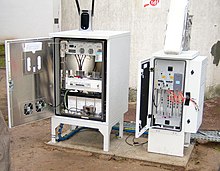വൈമാക്സ്
 |

വലിയ ഭൂപ്രദേശങ്ങളിൽ പോലും കമ്പിയില്ലാകമ്പി രീതിയിൽ ഉയർന്ന വേഗത്തിലുള്ള ഇന്റർനെറ്റ് സേവനം ലഭ്യമാക്കുന്ന വാർത്താവിനിമയ സാങ്കേതിക വിദ്യയാണ് വൈമാക്സ് എന്ന വേൾഡ് വൈഡ് ഇന്റർഓപ്പറബിലിറ്റി ഫോർ മൈക്രോവേവ് ആക്സസ്. ഫിസിക്കൽ ലെയർ (PHY), മീഡിയ ആക്സസ് കൺട്രോൾ (MAC) ഓപ്ഷനുകൾ നൽകുന്ന ഐഇഇഇ(IEEE) 802.16 സെറ്റ് സ്റ്റാൻഡേർഡുകളെ അടിസ്ഥാനമാക്കിയുള്ള വയർലെസ് ബ്രോഡ്ബാൻഡ് കമ്മ്യൂണിക്കേഷൻ മാനദണ്ഡങ്ങളുടെ ഒരു കുടുംബമാണ്. വാണിജ്യ വെണ്ടർമാർക്കുള്ള സിസ്റ്റം പ്രൊഫൈലുകളുടെ നിർവചനം ഉൾപ്പെടെ, ഇന്റർഓപ്പറബിലിറ്റിയും പരസ്പരമുള്ള പ്രവർത്തനക്ഷമതയും പ്രോത്സാഹിപ്പിക്കുന്നതിനായി 2001 ജൂണിൽ വൈമാക്സ് ഫോറം രൂപീകരിച്ചു.[1]
2005 ലെ വൈമാക്സ് പതിപ്പ് 40 Mbit/s [2][3] വരെയുള്ള ഡാറ്റാ നിരക്ക് ലഭ്യമാക്കിയെങ്കിൽ 2011 ലെ പുതിയ പതിപ്പിനു 1 Gbit/s വരെയുള്ള ഡാറ്റാ നിരക്ക് നൽകും. ഫോർ.ജി എന്നറിയപ്പെടുന്ന നാലാം തലമുറയിൽപ്പെട്ട ഒരു കമ്പിയില്ലാകമ്പി വാർത്താവിനിമയ സാങ്കേതിക വിദ്യയായ വൈമാക്സ്, 30 മീറ്റർ (100 അടി)മാത്രം പരിധിയുള്ള സാധാരണ വൈ-ഫൈ സേവനത്തെ മറി കടക്കുന്നു. കേബിൾ മോഡം, ഡി.എസ്.എൽ എന്നിവയേക്കാൾ പതിന്മടങ്ങ് വേഗതയുള്ള വൈമാക്സ് നിലവിൽ 75 Mbit/s വേഗത്തിലുള്ള ഡാറ്റ നിരക്ക് വാഗ്ദാനം ചെയുന്നു.
വൈമാക്സ് റിലീസ് 2.1, വൈമാക്സ് 2+ എന്ന പേരിൽ ജനപ്രിയമായി ബ്രാൻഡ് ചെയ്യപ്പെടുന്നു, മുൻ വൈമാക്സ് തലമുറകളിൽ നിന്ന് ബാക്ക്വേഡ്-കമ്പാറ്റിബിലിറ്റി ട്രാൻസിഷനാണിത്. ഇത് ടിഡി-എൽടിഇയുമായി പൊരുത്തപ്പെടുന്നതും പരസ്പരം പ്രവർത്തിക്കാവുന്നതുമാണ്.
ടെർമിനോളജി
[തിരുത്തുക]വൈമാക്സ് എന്നത് വൈമാക്സ് ഫോറം അംഗീകരിച്ച ഐഇഇഇ 802.16 വയർലെസ്-നെറ്റ്വർക്കുകളുടെ കുടുംബത്തിൽ നടപ്പാക്കുന്ന ഇന്റർഓപ്പറബിൾ നടപ്പിലാക്കലുകളെ സൂചിപ്പിക്കുന്നു. (അതുപോലെ തന്നെ, വൈ-ഫൈ(Wi-Fi) അലയൻസ് സാക്ഷ്യപ്പെടുത്തിയ ഐഇഇഇ 802.11 വയർലെസ് ലാൻ സ്റ്റാൻഡേർഡുകളുടെ ഇന്റർഓപ്പറബിൾ നടപ്പിലാക്കലുകളെയാണ് വൈ-ഫൈ സൂചിപ്പിക്കുന്നത്.) വൈമാക്സ് ഫോറം സർട്ടിഫിക്കേഷൻ വെണ്ടർമാരെ വൈമാക്സ് സർട്ടിഫൈഡ് ആയി മൊബൈൽ ഉൽപ്പന്നങ്ങൾ വിൽക്കാൻ അനുവദിക്കുന്നു. അങ്ങനെ, മറ്റ് സർട്ടിഫൈഡ് ഉൽപ്പന്നങ്ങൾ ഒരേ പ്രൊഫൈലിന് അനുയോജ്യമാകുന്നിടത്തോളം അവയുമായി പരസ്പര പ്രവർത്തനക്ഷമതയുടെ ഒരു തലം ഉറപ്പാക്കുന്നു.
ഇതും കൂടി കാണുക
[തിരുത്തുക]- മൊബൈൽ ബ്രോഡ്ബാൻഡ്
അവലംബം
[തിരുത്തുക]- ↑ Pinola, Jarno; Kostas Pentikousis (2008). "Mobile WiMAX". The Internet Protocol Journal. Cisco. Archived from the original on 2016-08-21. Retrieved 2016-08-05.
- ↑ "Mobile WiMAX Speed Test Results in Perth, Australia - 1 to 37 Mbps, 12mbps Average". Retrieved 2010-04-14.
- ↑ Carl Weinschenk (April 16, 2010). "Speeding Up WiMax". IT Business Edge. Archived from the original on 2011-09-05. Retrieved August 31, 2011.
Today the initial WiMax system is designed to provide 30 to 40 megabit per second data rates.
പുറത്തേക്കുള്ള കണ്ണികൾ
[തിരുത്തുക]- വൈമാക്സ് ഫോറം
- എന്താണ് വൈമാക്സ് Archived 2012-03-18 at the Wayback Machine.
Mobile telephony standards | |
|---|---|
| 0G (radio telephones) | MTS · MTA · MTB · MTC · IMTS · MTD · AMTS · OLT · Autoradiopuhelin |
| 1G | |
| 2G | |
| 2G transitional (2.5G, 2.75G) | |
| 3G (IMT-2000) | |
| 3G transitional (3.5G, 3.75G, 3.9G) | |
| 4G (IMT-Advanced) | |
| 5G | |
| Related articles | History · Cellular network theory · List of standards · Comparison of standards · Channel access methods · Spectral efficiency comparison table · Cellular frequencies · GSM frequency bands · UMTS frequency bands · Mobile broadband |
Text is available under the CC BY-SA 4.0 license; additional terms may apply.
Images, videos and audio are available under their respective licenses.
